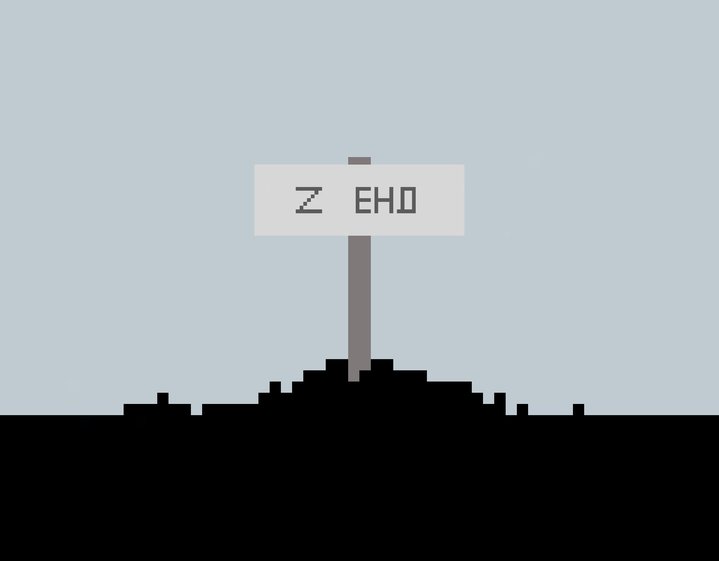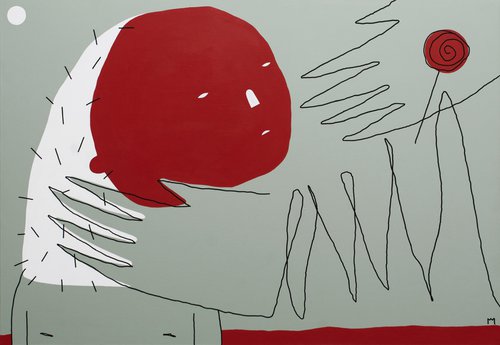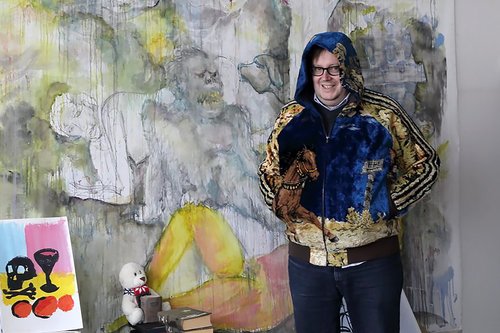Ivan Tuzov’s Pixels in a Time of Tragedy

Ivan Tuzov. Untitled, 2022. Digital art. Courtesy of the artist
A Russian artist who is known for his deceptively simple, pixel-based work has unveiled a benefit exhibition in Montenegro’s Tivat. Bringing together both recent and earlier works, it reveals how the artist’s signature pixelated images have gained new powers of conviction due to the tragic times in which they were created.
My first encounter with Ivan Tuzov (b.1984) was in a toilet. He had installed a site-specific pixelated mosaic in the first floor lavatory in the headquarters of a vast, disused port transformed by mega curator and culturtraeger Marat Guelman (declared a foreign agent by Russian authorities) into an artist’s residency, exhibition and studio hub. Tuzov had masterfully and wittily added mosaics of pixelated characters, semi-naked holidaymakers and sailors to the existing chipped tiles. The installation referenced both Soviet traditions of public art and the local context, poking fun at them and at the same time creating a wonderful, playful meditation space, one which I often used.
It was later on that I learnt about Ivan Tuzov’s service to post-soviet pixel art. It’s a self-explanatory genre, deliberately reductive in an age of boundless digital art. It limits itself to minimal visual information, requiring both economy and precision; playing with iconic popular images and symbols which are recognisable from just a few squares of colour.
In the 2010s Tuzov’s images became execptionally popular as memes, his combination of pixel art with post-soviet imagery hit the mark. Symptomatic of his generation, he spoke for and to millennials. This generation concurrently witnessed the decline of Soviet culture – only its fragments remaining as visual debris in the form of leftover Lenin statues and retro packaging - and the rapid onset of the Internet age, which progressed quickly from basic computer games, to sophisticated AI-generated virtual worlds. The combination of these two nostalgias created a potent brew, a pop art lo-fi take on iconic imagery; perhaps an updated version of the Sots Art movement.
In a 2013 interview Tuzov called himself an apolitical artist and professed not to work with images of Putin. However, in his current exhibition ‘Before and After’ (Do I Posle) there are twelve works depicting Putin, which reveals just how artists have been forced to reconsider their positions this year. It is as if apolitical is no longer an option. As the title of the show suggests, Tuzov himself, as all Russian artists, faces a divide. It is the before and after, however differently each artist may react to it.
Tuzov’s ‘after’ features two main characters. “Ivan creates two archetypes: Putin and a dead soldier”, explains Marat Guelman, the show’s co-curator. “Cruelty and submission. Killer and deadman.” Tuzov only depicts the Russian side because, as he puts it, he didn’t feel he had the right to approach the Ukrainian perspective. Proving to be the most popular work is a clearly recognisable pixelated image of a dead Russian soldier lying on the ground with a speech bubble coming from the corpse: “first time abroad,” it says. A terrifying predicament for new conscripts. Most of the works play on an obvious double entendre and involve text, much of which references Russian sayings or popular quotes which get lost in translation, the intended audience are clearly Russian speakers. Most of the works were made after the 21st of September, the date Russia announced its mobilization. Tuzov himself had been living outside Russia since 2021.
The exhibition is held in the cultural venue of the Montenegrin Non-profit Pristanište, founded in March 2022 to help refugees from Ukraine, Russia and Belarus find their feet in Montenegro, offering temporary accommodation and advice to hundreds of people fleeing their homes. The proceeds from the show will be donated to this organisation.
To provide a wide scope for comparison, the exhibition also includes the artist’s older works, such as the 2018 series ‘Osmogel’, a fictional computer game ridiculing the conflict between two Russian art world personages, Guelman himself and his nemesis, the radical artist and theorist Anatoly Osmolovsky (b. 1969) (declared a foreign agent by the Russian authorities). It is remarkable how Tuzov’s work has made a leap in depth and complexity since then, yet with almost no visible change on the surface of it. Tuzov has managed to find a balance in the fine line between tragedy and comedy, where previously, his pixelated filter seemed like a guaranteed injection of light-heartedness to almost any serious subject matter. These latest works prove that it is not so simple to dare to apply humour to the horrendous massacre of thousands of innocent victims. It is a very difficult and risky task, and yet offsetting this tragedy with irony poked at its perpetrators gives depth and complexity to seemingly flat images. They have the potential to grab popular attention, and serve a true purpose in conveying a message to the masses. It is one of warning against participation in this bloodshed, the artist hopes.
The third and final room shows paintings uncharacteristic for Tuzov, a series called ‘Hiding Behind Masks’ (Skryvayas za Maskami). The series, Tuzov explains was an experiment to represent contemporary Russian society and the attempt to find forms that might still be shown or sold within Russia. This is a challenge for any honest, oppositional artist, considering the stifling censorship. These layered canvases with washes of colour in the background and linear brushstrokes at the fore, are the painterly opposite of all the sharp, flat simplicity of his pixels. As well as studying contemporary art, Tuzov has a classical art training with specialisation in the exceptionally laborious analogue technique of marquetry or wooden mosaic. This dichotomy and schism of a digital artist trained classically is felt in Tuzov’s work, often wanting, it seems, to return virtual artworks to the physical realm.
Typecast as ‘the pixel artist’ it is clearly challenging to break the mould of a successful trademark and it seems Tuzov has unwittingly applied to himself the same oversimplification and reduction which he uses on his pixel hero subjects. Tuzov is a mid-career artist still in the search for new forms of development and self-expression but the current political situation called him back to his trademark, which it seems has come into its own fully now. The meme language has the potential to speak louder and carry messages beyond exhibition walls, a more urgent task in a time of crisis.















